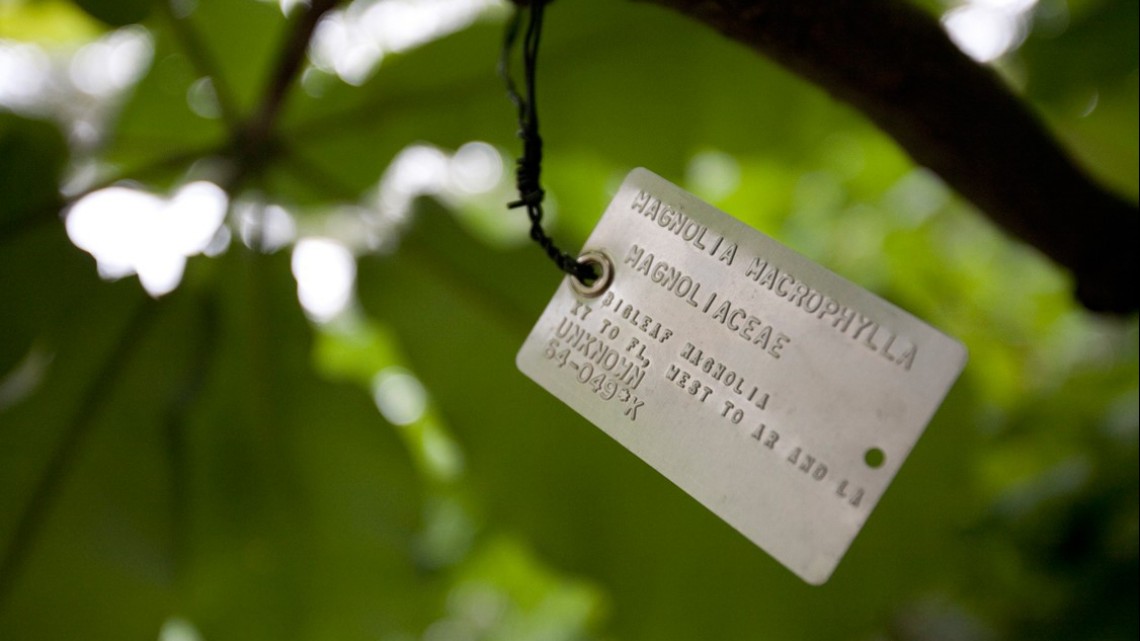
A tagged magnolia tree at Cornell Botanic Gardens.
Cornell Botanic Gardens’ wins grant to make plant records accessible
By Shannon Dortch
Cornell Botanic Gardens has received a $192,000 grant from the federal government’s Institute of Museum and Library Services in support of a $384,000 project to upgrade and digitize its plant collections records. The grant will enable the Botanic Gardens to transfer its plant records system to a more sophisticated database platform, to digitize tree health and pest management data, and to integrate plant records in a new website, making them widely accessible.
The new systems will enhance care and conservation of collections for which permanent, individual plant records are maintained. These include 10,078 plants and 3,400 trees. The upgrades will also make it easy to share these records with the widest possible audience.
While the Botanic Gardens’ records are accurate and up-to-date, the new digital platform will allow it to expand and enhance access to those records for collections stewardship, research and the benefit of the public. In addition, the upgrades support the Botanic Gardens’ strategic goal of raising awareness of critical relationships between plants and people and inspiring action to conserve biological and cultural diversity.
“Well-curated and accessible plant collections enhance the potential for people to appreciate and connect with plants,” said Christopher Dunn, the Elizabeth Newman Wilds Executive Director of Cornell Botanic Gardens. “Encouraging connection to the environment is critical in an era when we are increasingly detached from the natural world and climate change threatens biological and cultural diversity.”
The grant funds a 15-month project to enhance the botanic gardens’ collections database and digitize its Integrated Pest Management (IPM) and Tree Risk Assessment Program (TRAP). The plant records database will migrate to a system in which users can understand and map layers of data.
Plant stewardship and management will improve dramatically, as the new system provides for digital integration of pest and disease scouting records and tree risk assessments that are currently kept in paper logbooks. Further integration of plant, IPM and TRAP data with Cornell Botanic Gardens’ website will enable staff to easily access data and provides users with a portal to the Botanic Gardens’ plant collections for research, teaching and learning.
“As a result of this project, collection data will be accessible from mobile devices, available in real time, and mapped so that plants can be easily located, tracked and effectively managed,” Dunn said. “Enhanced accessibility of plant records benefits the 5,000 students, faculty and community learners who engage with us each year, and the more than 70,000 annual visitors to our gardens, arboretum and natural areas.”
The project could potentially serve as a model for horticulture research institutions, which face similar challenges in their stewardship efforts, said Thomas Björkman, chair of the Geneva Arboretum Association and professor of horticulture at the Cornell AgriTech campus in Geneva, New York.
“We’re watching this project with interest, as the tools and procedures being developed could greatly improve the management of our tree collection,” he said.
Migration of plant records and input of IPM and TRAP records to the new database platform is expected to be completed in early spring 2019, with detailed mapping work continuing through the project’s end in December 2019. Website integration should be completed by June 2019.
Shannon Dortch is associate director of communications and marketing at Cornell Botanic Gardens.
Media Contact
Get Cornell news delivered right to your inbox.
Subscribe